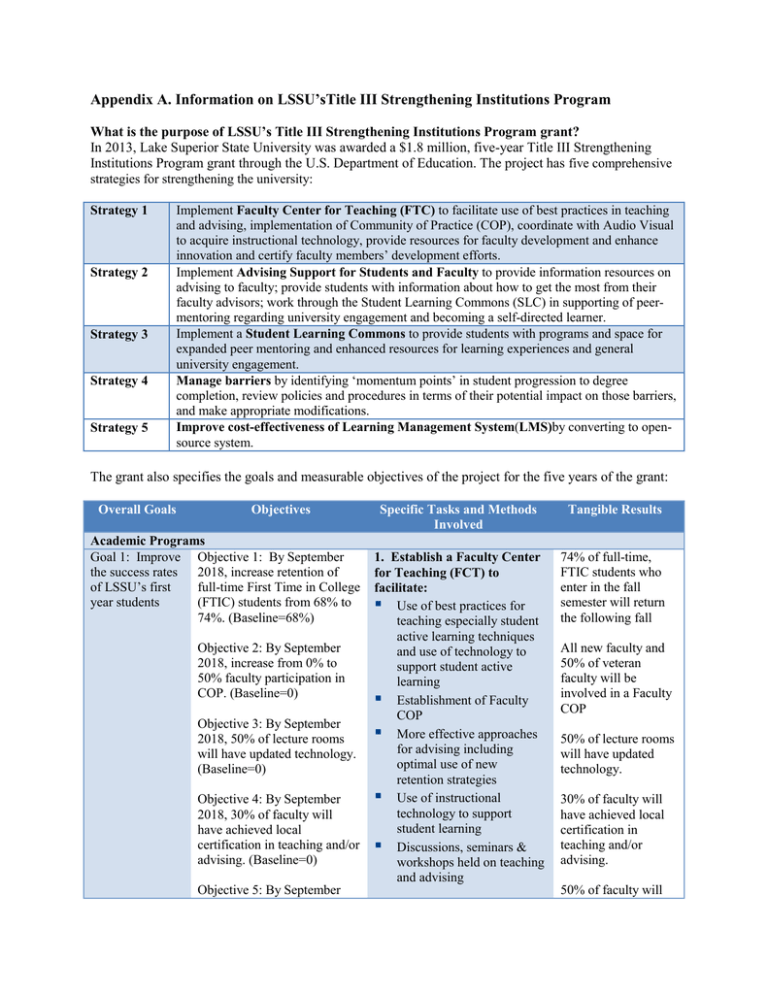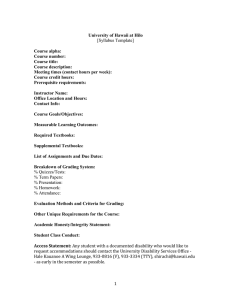Appendix A. Information on LSSU’sTitle III Strengthening Institutions Program
advertisement

Appendix A. Information on LSSU’sTitle III Strengthening Institutions Program What is the purpose of LSSU’s Title III Strengthening Institutions Program grant? In 2013, Lake Superior State University was awarded a $1.8 million, five-year Title III Strengthening Institutions Program grant through the U.S. Department of Education. The project has five comprehensive strategies for strengthening the university: Strategy 1 Strategy 2 Strategy 3 Strategy 4 Strategy 5 Implement Faculty Center for Teaching (FTC) to facilitate use of best practices in teaching and advising, implementation of Community of Practice (COP), coordinate with Audio Visual to acquire instructional technology, provide resources for faculty development and enhance innovation and certify faculty members’ development efforts. Implement Advising Support for Students and Faculty to provide information resources on advising to faculty; provide students with information about how to get the most from their faculty advisors; work through the Student Learning Commons (SLC) in supporting of peermentoring regarding university engagement and becoming a self-directed learner. Implement a Student Learning Commons to provide students with programs and space for expanded peer mentoring and enhanced resources for learning experiences and general university engagement. Manage barriers by identifying ‘momentum points’ in student progression to degree completion, review policies and procedures in terms of their potential impact on those barriers, and make appropriate modifications. Improve cost-effectiveness of Learning Management System(LMS)by converting to opensource system. The grant also specifies the goals and measurable objectives of the project for the five years of the grant: Overall Goals Objectives Academic Programs Goal 1: Improve Objective 1: By September the success rates 2018, increase retention of of LSSU’s first full-time First Time in College year students (FTIC) students from 68% to 74%. (Baseline=68%) Objective 2: By September 2018, increase from 0% to 50% faculty participation in COP. (Baseline=0) Objective 3: By September 2018, 50% of lecture rooms will have updated technology. (Baseline=0) Objective 4: By September 2018, 30% of faculty will have achieved local certification in teaching and/or advising. (Baseline=0) Objective 5: By September Specific Tasks and Methods Involved Tangible Results 1. Establish a Faculty Center for Teaching (FCT) to facilitate: Use of best practices for teaching especially student active learning techniques and use of technology to support student active learning Establishment of Faculty COP More effective approaches for advising including optimal use of new retention strategies Use of instructional technology to support student learning Discussions, seminars & workshops held on teaching and advising 74% of full-time, FTIC students who enter in the fall semester will return the following fall All new faculty and 50% of veteran faculty will be involved in a Faculty COP 50% of lecture rooms will have updated technology. 30% of faculty will have achieved local certification in teaching and/or advising. 50% of faculty will 2018, increase from 0% to 50% faculty using resources available through the Faculty Center for Teaching (FCT). (Baseline=0) Objective 6: By September 2018, increase 6 year graduation rate to 38%. (Baseline=33%) Objective 7: By September 2018, increase percentage of faculty members using MAPWorks to 70%. (Baseline=30) Objective 8: By September 2018, 55% of first year students surveyed will indicate they are accessing on-line tutorials about academic planning. (Baseline=0) Objective 9: By September 2018, 35% of first year students will be working with a peer mentor. (Baseline=13) Acquiring of print/electronic resources available for faculty professional development Funding available for attending conferences Funding available for innovative practices through a min-grant program Creation of local certification program for faculty in the areas of enhancing student learning and in advising 2. Establish Enhanced First Year Advising program: Increase student participation in retention management system Increase faculty participation in retention management system Provide enhanced advising resources for advisors and students including on-line tutorials for academic planning to help students get the most from their advisors make use of resources in the FCT. 38% of studentsentering fall 2013 will be on track to graduate in 6 years. 70% of faculty use MAP-works for advising 55% of first year students surveyed will indicate they are accessing on-line tutorials about academic planning 35% of first year students will be working with a peer mentor during their first year. 3. Establish a Student Learning Commons: Provide increase student access to peer mentoring Increase student access to support for student active learning within their classes Enhance the physical location where students can access support services Institutional Management Goal 2: Identify Objective 10: By September and remove 2018, 80% of policies and policies and procedures will have been procedures that reviewed for their potential unnecessarily act impact on degree as barriers to completion.(Baseline=0) degree completion 4. Manage Barriers: Staff in the Office for Advising, Retention and Orientation will facilitate an analysis of students’ individual academic and personal needs, including ‘momentum points’ in 80% of campus policies and procedures that impact degree completion will be reviewed and appropriate recommendation Goal 3: Improve cost efficiency in use of Learning Management System (LMS) Objective 11: By September 2018, 100% of faculty who use LMS will be using Moodle. (Baseline=0). student progression to degree completion and review policy and procedures in terms of their potential impact on them 5. Convert to open-source LMS: Begin process of converting to Moodle as we approach end of current license with Blackboard™ will have been made. 100% of faculty who use LMS in their classes will be using Moodle.
